XENON100 Experiment
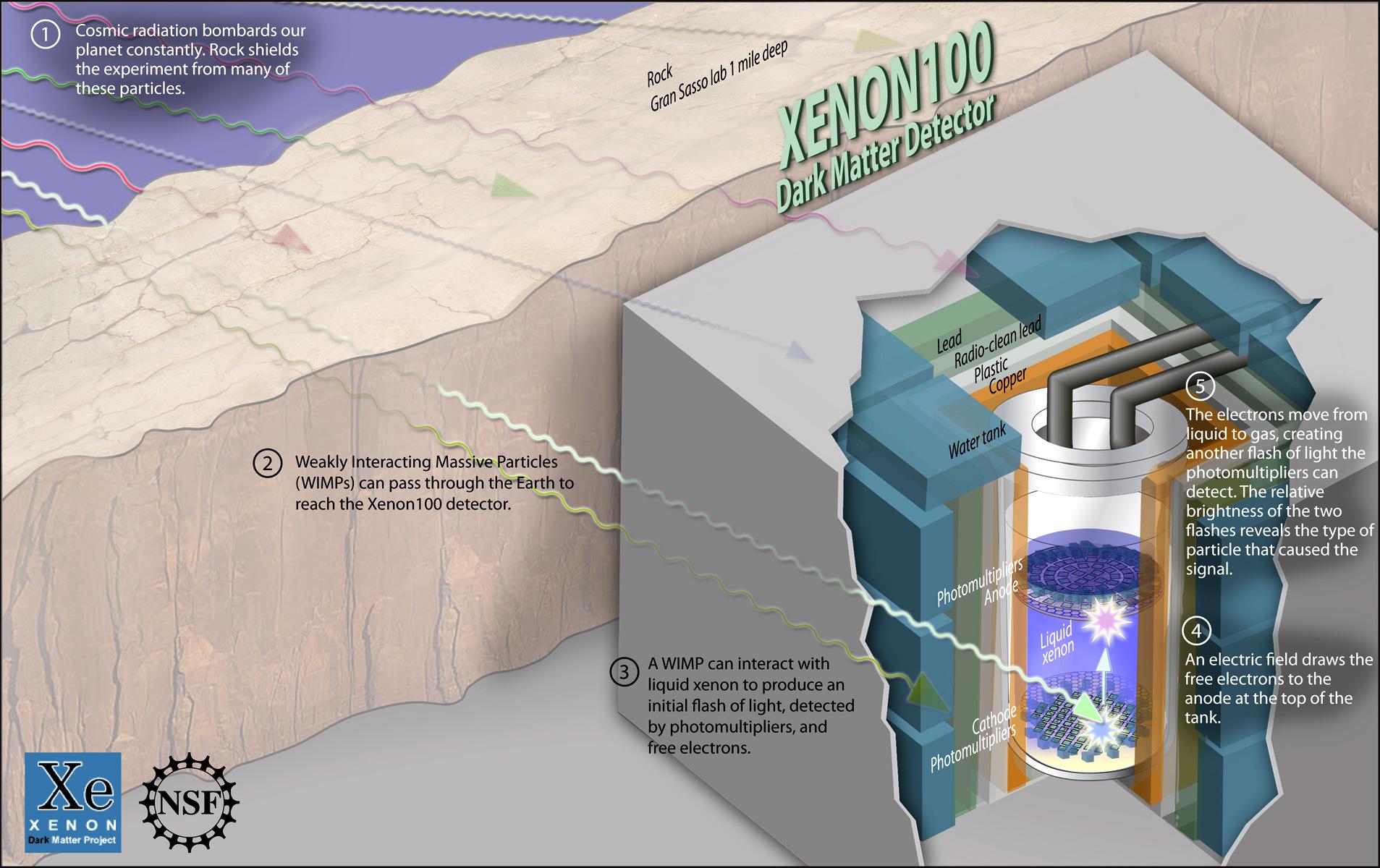 The XENON100 experiment is located in the Gran Sasso mountain in central Italy, and is a new dark matter search experiment, aiming to increase the fiducial liquid xenon target mass to 100 kg with a 100 times reduction in background rate, compared to the XENON10 experiment. The XENON100 experiment is located in the Gran Sasso mountain in central Italy, and is a new dark matter search experiment, aiming to increase the fiducial liquid xenon target mass to 100 kg with a 100 times reduction in background rate, compared to the XENON10 experiment.
The XENON100 detector uses the same principle of operation and many design features successfully tested in the XENON10 prototype. It is a position-sensitive XeTPC, with the sensitive LXe volume viewed by two arrays of total 178 photomultiplier tubes (PMTs), to detect simultaneously the primary scintillation signal (S1) and the ionization signal via the proportional scintillation mechanism (S2). The active target is enclosed in a PTFE cylinder of 15 cm radius and 30 cm height. 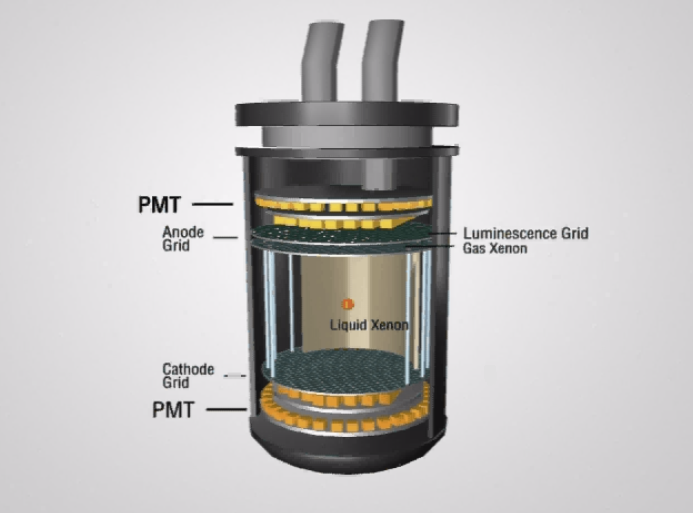 This PTFE cylinder reflects scintillation light with high efficiency, and optically separates the LXe target from the surrounding LXe which is necessary to separate the TPC with its electric field from the walls of the vessel. 64 PMTs turn this outer LXe volume into an active LXe veto, with a total mass of 105 kg, including LXe layers above the top and below the bottom PMT arrays. More photo about this detector during it's assembly and installation can be found in Photo Gallery
By clicking in the picture on the left, a movie will start showing the detection principles of the XENON100 TPC. This PTFE cylinder reflects scintillation light with high efficiency, and optically separates the LXe target from the surrounding LXe which is necessary to separate the TPC with its electric field from the walls of the vessel. 64 PMTs turn this outer LXe volume into an active LXe veto, with a total mass of 105 kg, including LXe layers above the top and below the bottom PMT arrays. More photo about this detector during it's assembly and installation can be found in Photo Gallery
By clicking in the picture on the left, a movie will start showing the detection principles of the XENON100 TPC.
The XENON100 experiment has recently released results from the last run (2011-2012). These data were acquired over 224.6 days within a fiducial volume containing 34 kg of liquid xenon and with an ultra low electromagnetic background. After unblinding the region of interest, two events were observed, consistent with the total background expectation of (1.0 ± 0.2) events.
A Profile Likelihood analysis of these data leads to the upper limit on the spin independent elastic WIMP-nucleon scattering cross section ( σSI), with a minimum of 2 x 10-45 cm2 at 55 GeV/c2 and 90% confidence level,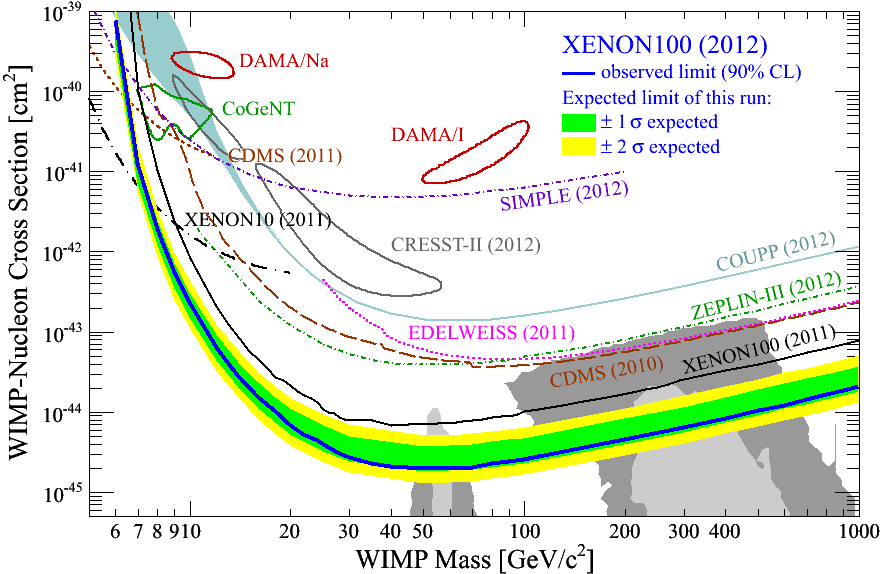 which are shown in the picture on the left, and corresponds to the present best experimental upper limit set on σSI. which are shown in the picture on the left, and corresponds to the present best experimental upper limit set on σSI. For comparison, the results from a selection of other experiments are also shown along with the most likely parameter space for a positive detection as predicted by the Constrained Minimal Supersymmetric Extension of the Standard Model (cMSSM) and in accordance with the latests results from the LHC.
The most recent status of XENON100 can be found in Presentations.
Background Prediction
The materials used in the XENON100 TPC and shield were carefully selected for low intrinsic radioactivity. The sensitive target can be "fiducialized" to keep only the inner core free of background. Monte Carlo simulations, based on these measured radioactivity,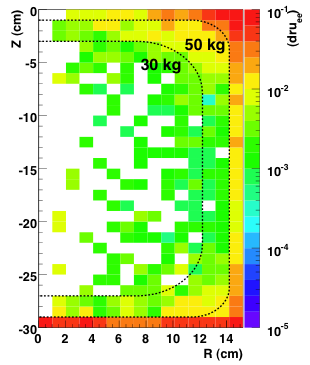 predict an electron recoil background rate to be less than 3 mDRU (mDRU = 10-3 evts/keVee/kg/day) in the 30-kg inner fiducial target. Such a low background rate enables us to search for WIMPs with a raw exposure of 6000 kg-day with no gamma background event. The nuclear recoil background produced by neutrons will be even less. predict an electron recoil background rate to be less than 3 mDRU (mDRU = 10-3 evts/keVee/kg/day) in the 30-kg inner fiducial target. Such a low background rate enables us to search for WIMPs with a raw exposure of 6000 kg-day with no gamma background event. The nuclear recoil background produced by neutrons will be even less.
Krypton Removal
LXe, as a condensed noble gas, is readily purifiable for most radioactive impurities. The one notable exception is Kr, presents in commercial Xe gas at the ppm (part per million) level. Beta decays of 85Kr (687~keV end point, 10.76 years of half life) presents a serious background for a dark matter search.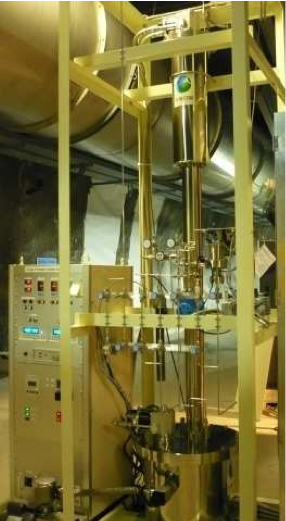 The gas used in XENON100 was processed by the Spectra Gases Company to reduce the Kr concentration to 5~ppb, while XENON100 requires another two or three orders of magnitude lower Kr concentration. We have purchased a small-scale cryogenic distillation column made by Taiyo-Nippon Sanso Co. The column has been commissioned at LNGS and has been already used to purify part of the XENON100 gas. The gas used in XENON100 was processed by the Spectra Gases Company to reduce the Kr concentration to 5~ppb, while XENON100 requires another two or three orders of magnitude lower Kr concentration. We have purchased a small-scale cryogenic distillation column made by Taiyo-Nippon Sanso Co. The column has been commissioned at LNGS and has been already used to purify part of the XENON100 gas.
|